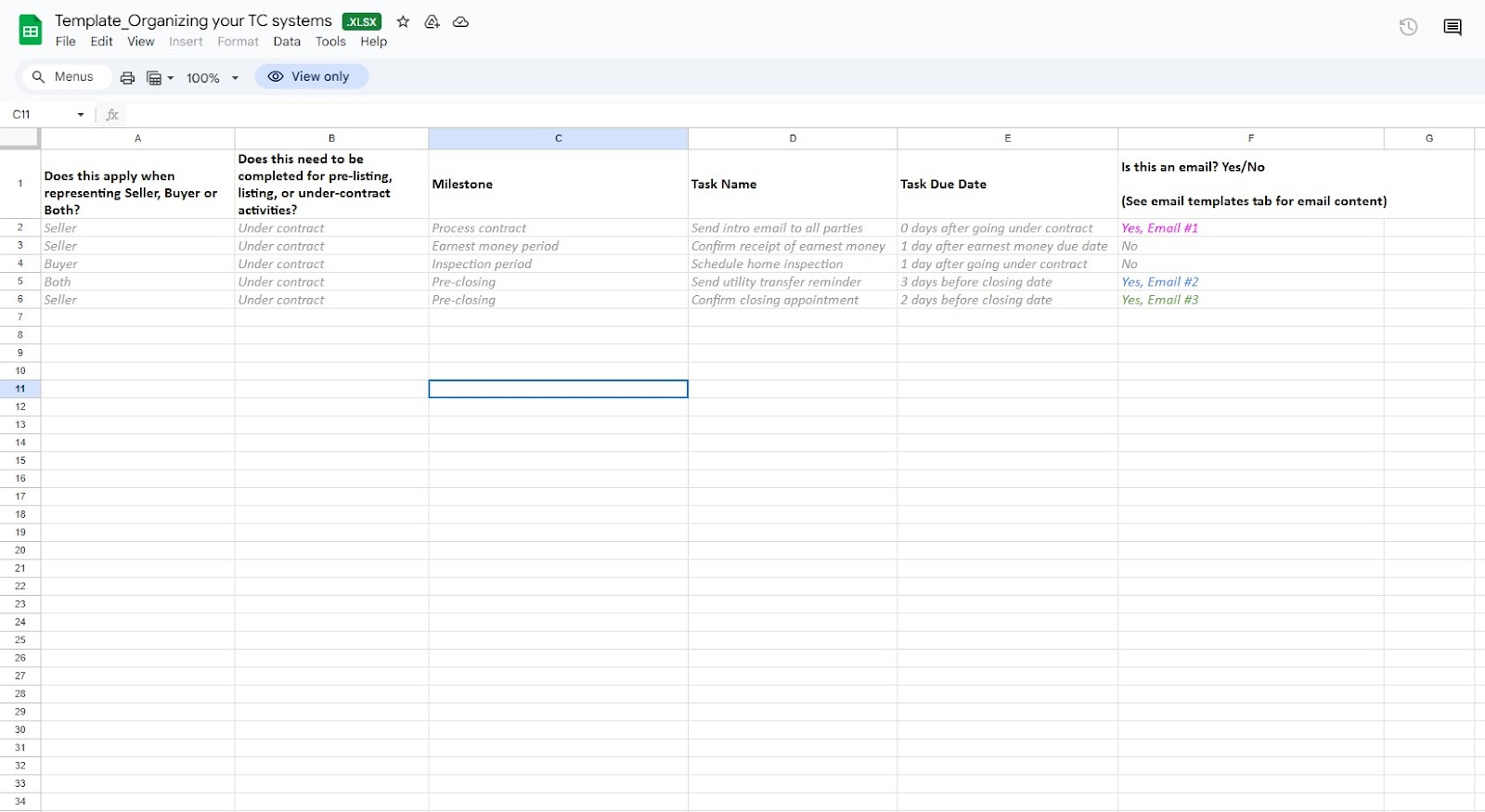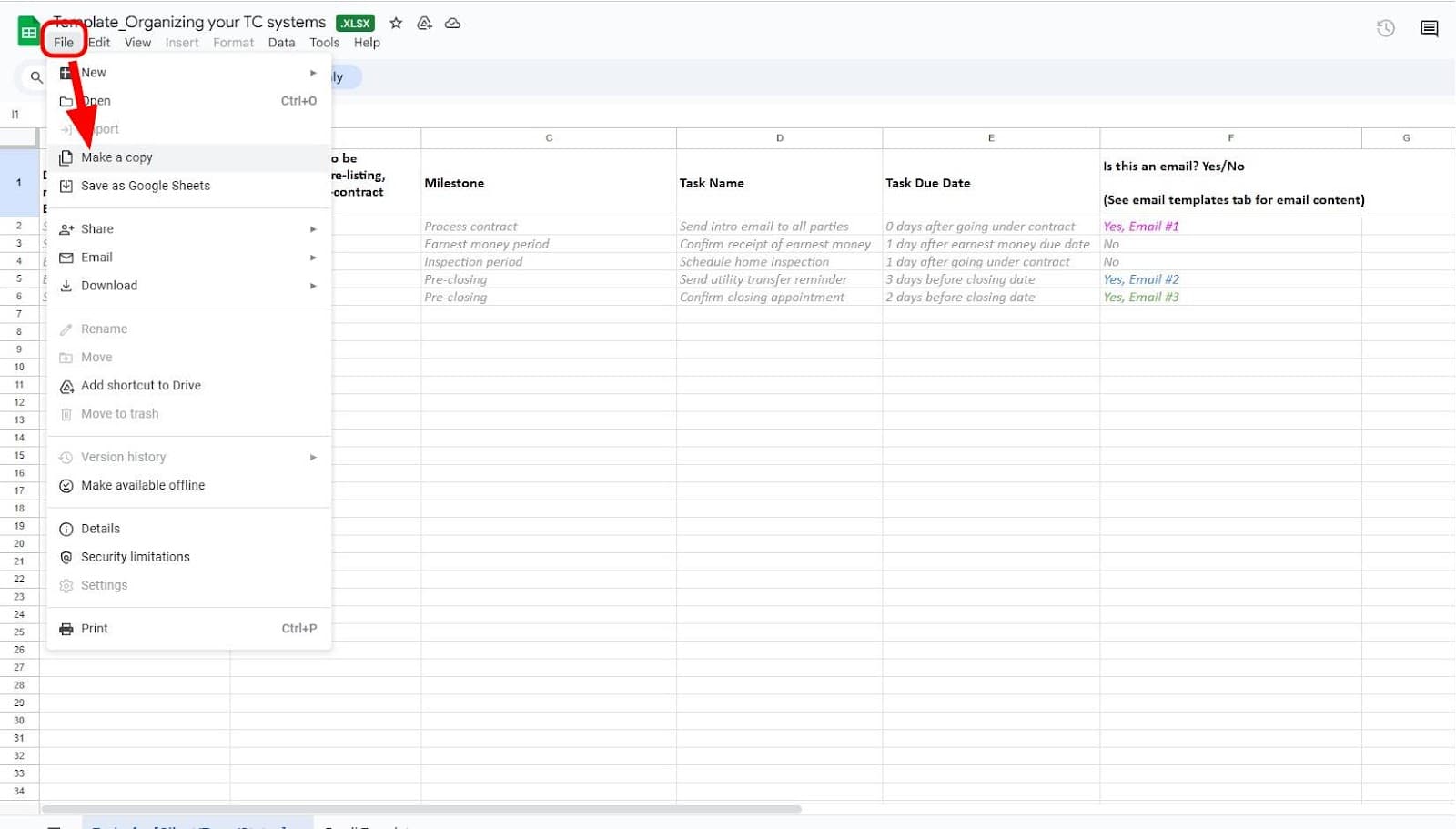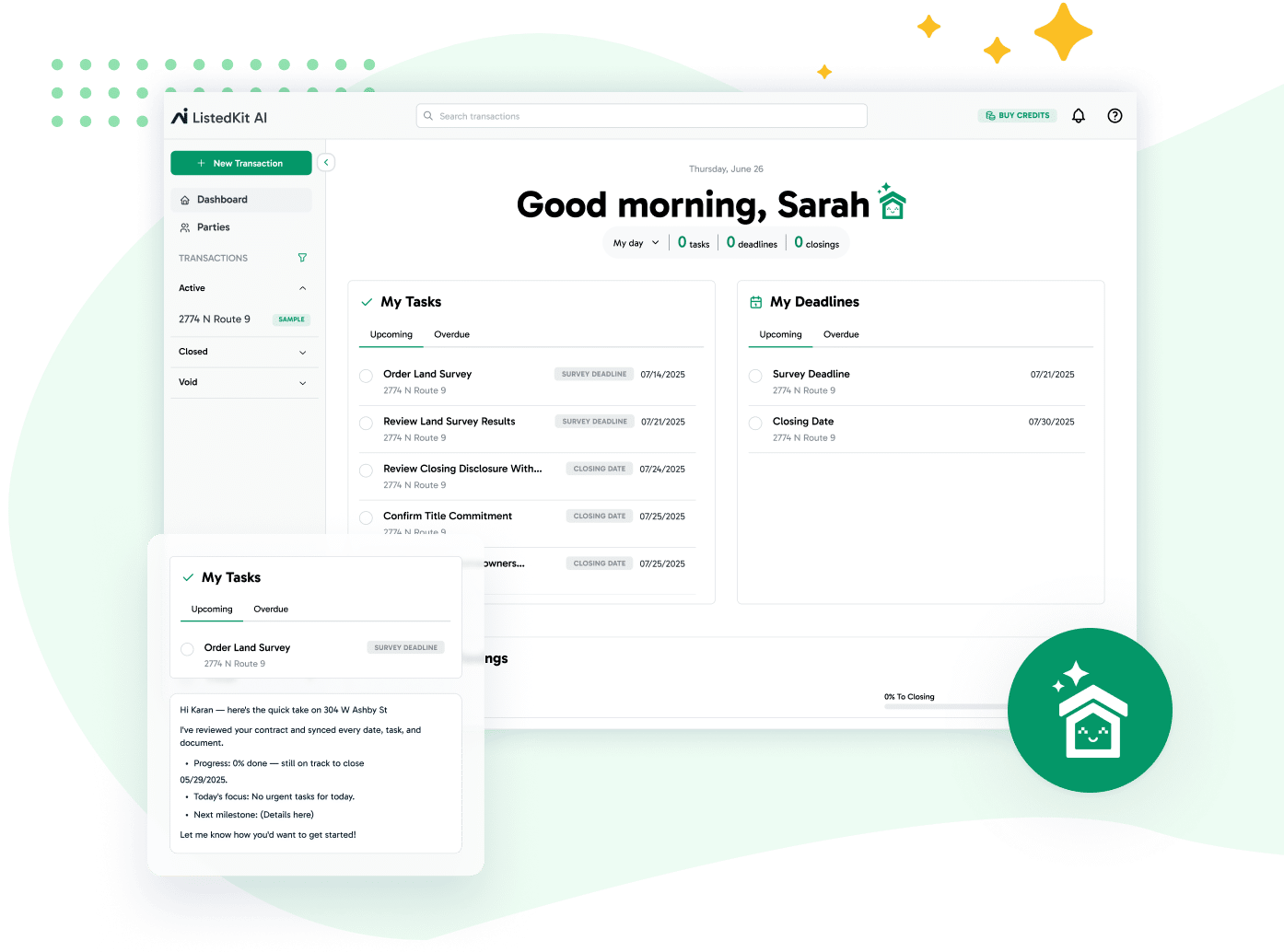Organizing tasks can quickly become a full-time job, especially when you’re staring at a half-built checklist, a messy Google Drive, and a calendar that doesn’t match the contract.
If your current system is a patchwork of reminders, folders, and inbox searches—and you’re still tweaking it weekly—this guide is for you.
It’s a clear, opinionated walkthrough for mapping task lists, timelines, and email templates in a way that works across buyer and seller sides. Let’s get started!
Want an easier way to get started?
Use our free template to organize tasks, timelines, and emails without starting from scratch.
Organizing Tasks by Role and Timeline, Not Just Preference
Many coordinators make the first mistake of trying to build their workflow around memory or preference instead of structure.
Organizing tasks effectively means mapping them to roles, transaction stages, and clear outcomes—not personal habits.
You’ll want to split your system into two tracks: buyer-side and seller-side. This helps avoid confusion and makes your templates easier to scale. Within each track, break things down into four stages:
- Pre-contract
- Active contract
- Closing prep
- Post-close
Then, define your task list based on what each stage demands. For example:
- Pre-contract (Buyer Side). Verify contact details with the agent, request buyer rep agreement, send a confirmation email to the client.
- Active contract (Seller Side). Schedule inspection, send the contract to title companies, send reminder emails about disclosures.
Ask yourself these questions:
- Does this task move the deal forward or improve the customer experience?
- Who owns it? You? The agent? A third party?
- When does it need to happen in the timeline?
Using a visual task management tool helps you lay this out clearly. With customizable boards, you can drag and drop task cards between transaction stages, add detailed task descriptions, and track time spent on individual tasks.
Once this foundation is in place, you can reuse and adapt it with minimal adjustment—whether the transaction is in a major market or a niche location.
A Timeline-First Approach Brings Clarity to Chaos
Starting with tasks before timelines is like writing emails without knowing who they’re for. Timelines add structure and show which parts of the process are time-sensitive and flexible.

A solid timeline begins with your standard milestones:
- Offer acceptance
- Inspection due date
- Appraisal ordered and received
- Financing contingency
- Closing scheduled
From there, work backward. Let’s say your inspection is due by Day 10. That means:
- On Day seven, the buyer needs a reminder email.
- On Day five, the inspector needs to be confirmed.
- On Day three, the client may need a friendly reminder with prep instructions.
Attaching tasks to contract events (rather than calendar dates) prevents errors. You’ll stop missing things like “Send seller escrow packet” because the system moves with the contract timeline. That flexibility is a key feature of tools like ListedKit, which automatically connects task scheduling to milestone triggers.
When you plan this way, every email, confirmation, and task fires at the right moment—no more flipping between Google Drive folders, checking emails, or resending information manually.
The Decision Framework That Keeps You From Overbuilding
One of the fastest ways to overcomplicate your system is by adding too many tasks without filtering them. You can avoid that trap with a four-part framework that helps you choose only what matters:
- “Does it really need to be done?” If the task doesn’t impact closing, improve the client experience, or meet compliance, skip it.
- “Is it tied to a specific milestone?” For example, a shipping confirmation email for earnest money receipt is relevant only after funds hit escrow.
- “Does this task involve communication?” If yes, log it as a task and link it to a transactional email template—meaning, create or reference a ready-to-send email that covers this specific step (like an inspection reminder or escrow confirmation).
- “What’s the subject line, who gets it, and what should it say?” This avoids vague items like “Send update.” Be clear: “Send Inspection Confirmation Email to the buyer with PDF attachment.”
You can even layer this logic into popular task management software using tags like “email required” or “document needed.”
Stop Rewriting the Same Emails—Build a Real System Instead
You’ve likely typed the same intro email a dozen times. Maybe more. That’s time you’ll never get back—and it’s unnecessary once you commit to building a real system for transactional emails.
Start small. Build email templates for the eight most repeated messages:
- Welcome email (buyer and seller versions)
- Under contract update
- Inspection scheduled
- Escrow instructions
- Weekly check-in
- Closing confirmation
- Final walkthrough
- Post-close thank you
Each template should include:
- A helpful subject line that sets expectations (e.g., “Inspection Scheduled for Thursday – Please Confirm”)
- A clear, polite email body written in your voice
- Merge fields like [Client Name], [Closing Date], or [Property Address]
- Contact Information or an email signature block so clients always know how to reach you
Keep these templates in a centralized system, not across random documents or folders. Tools with built-in email builders help you format, reuse, and send without leaving your workspace.
Separating templates by seller, company, or region can also improve clarity and reduce email list mix-ups if you serve multiple teams or locations.
Consistency That Doesn’t Require Daily Maintenance
You don’t have time to check every email or reminder when transaction volume spikes. That’s why systems should be built to run with minimal upkeep. You can’t afford to forget an important reminder email or inspection confirmation just because your inbox is full.
Here’s what keeps things consistent:
- Tasks are grouped by transaction phase, making it easy to track upcoming tasks at a glance
- Transactional email templates are linked to tasks, so no one’s searching through old drafts
- Date logic is connected to milestones, reducing rescheduling chaos when contracts shift
- Email subject lines stay consistent, so your team knows what went out, when, and to whom
A task management platform like ListedKit improves team performance with real-time updates, audit logs, and assignment tools. You’ll know who completed what and when—without needing a follow-up Slack or call.
If you use customizable boards, color-coded task views, and status tags, your team can see what’s done and what’s late in seconds.
Start With This Template—Then Let Automation Do the Heavy Lifting
Instead of starting from scratch, begin with a working foundation that reflects real transaction workflows. This free template we’ve created is designed to remove that mental clutter and get you moving fast.
What You’ll See in the Template
The spreadsheet is already structured to support how most transaction coordinators think:

- Column A helps you filter tasks by whether they apply to the buyer, seller, or both sides.
- Column B distinguishes between pre-listing, listing, and under-contract tasks—so you don’t blend setup tasks with contract fulfillment.
- Column C focuses on contract milestones, like earnest money receipt or closing prep.
- Column D names the task (e.g., “Confirm closing appointment” or “Send utility transfer reminder”).
- Column E gives you the trigger date, calculated in relation to the contract—not a random calendar event.
- Column F confirms whether it’s a task-only email or also includes one (with links to the exact template you’ll use).
Use It, Copy It, Make It Yours
This spreadsheet is free to download. You don’t need to trade your email address or set up a new tool just to start.
Click the link below, select “File,” then “Make a copy.”

Now, you can edit the sheets and add milestones and due dates.
Pair it with ListedKit to make your system more efficient. Once you’ve mapped out your task list using the spreadsheet, you can upload that structure directly into ListedKit—bringing your static checklist to life with automation and real-time visibility.
Here’s how it works:
- Task dates adjust automatically when key milestones shift—like a new closing date or delayed inspection—so you don’t need to manually reschedule anything.
- You can assign project tasks to your team or yourself, track time, and monitor progress without leaving the platform.
- Built-in real-time collaboration tools keep everyone—agents, assistants, clients, and title companies—working on the same timeline.
DOWNLOAD THE FREE SPREADSHEET TEMPLATE HERE
Build a Calm, Confident Transaction System—One Task at a Time
The most effective systems aren’t complicated. They’re repeatable. They let you stop second-guessing and start working with clarity—even when deals pile up, dates shift, or inboxes overflow.
Here’s a quick recap of what makes this approach work:
- Structure your system by role and stage, not by memory. Break down tasks into four phases: Pre-contract, Active, Closing Prep, and Post-Close.
- Anchor your tasks to contract milestones so everything shifts with the deal—not the calendar.
- Use a decision framework to avoid overbuilding. Ask: Is it necessary? Date-based? Email-related? Who gets it, and what does it say?
- Build an email template library with clear subject lines, email bodies, and placeholders—then stop rewriting the same message every week.
- Keep everything visible and repeatable. Group your tasks. Link your email, link your tools, and start tracking.
- Start with the free spreadsheet template, then bring it to life using ListedKit for automation, scheduling, and real-time collaboration.
You don’t need to build from scratch. You just need to start with something that works.
Ready to turn this into a complete system? Book a free call with our team, and we’ll show you how ListedKit automates the work behind the scenes so you can focus on smooth closings and better client experiences.




